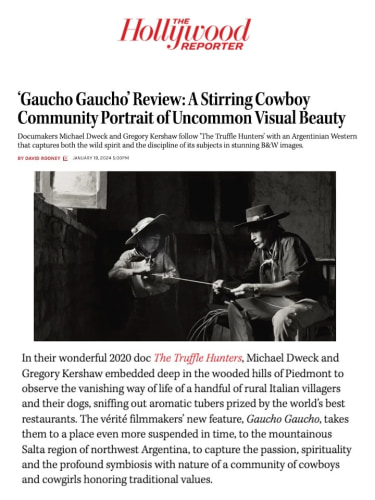‘Gaucho Gaucho’ Review: A Stirring Cowboy Community Portrait of Uncommon Visual Beauty
Hollywood Reporter
01/19/2024
Back
Documakers Michael Dweck and Gregory Kershaw follow ‘The Truffle Hunters’ with an Argentinian Western that captures both the wild spirit and the discipline of its subjects in stunning B&W images.
By David Rooney
In their wonderful 2020 doc The Truffle Hunters, Michael Dweck and Gregory Kershaw embedded deep in the wooded hills of Piedmont to observe the vanishing way of life of a handful of rural Italian villagers and their dogs, sniffing out aromatic tubers prized by the world’s best restaurants. The vérité filmmakers’ new feature, Gaucho Gaucho, takes them to a place even more suspended in time, to the mountainous Salta region of northwest Argentina, to capture the passion, spirituality and the profound symbiosis with nature of a community of cowboys and cowgirls honoring traditional values.
The film follows seven principal strands, each of them captivating in its own way and each of them accessing characters that very clearly relish their freedom from contemporary society. But the real stars are the magnificent black and white images shot by Dweck and Kershaw. The co-directors’ eye for composition allows them to find visual magic and an arresting sense of drama in every frame.
The cinematic sweep of this expertly crafted work is amplified by its eclectic music choices. (Kudos to music supervisor Jonathan Finegold.) The soundtrack might almost have been culled from the jukebox of some dusty Latin American cowboy bar off the beaten trail, with one glorious operatic addition. That would be “Au fond du temple saint” from Bizet’s The Pearl Fishers, which majestically accompanies an early slow-motion sequence of cowboys on horseback, galloping across the plains, their dogs running along behind them.
Elsewhere, the music ranges from Argentinian, Cuban and Venezuelan folk through the all-time banger of “La Balsa,” the 1967 debut single from Argentine rockers Los Gatos, to songs from contemporary freak-folk artists like Devendra Banhart and Alex Ebert, whose “Truth” has whistling and choral elements that evoke Sergio Leone Westerns.
Sticking to the co-directors’ characteristically observational approach, the subjects are never interviewed but instead caught in quiet moments of solitude, tending to their animals, stewarding the land or in conversation with family and other community members.
They range across the age spectrum, from “Jony,” a precocious 5-year-old boy eagerly soaking up every nugget of gaucho tradition his father Solano can impart, to Lelo, an 83-year-old veteran with a long snowy beard, spinning tales from his past of wine, women and wandering, swearing that he’d do it all over again if he could.
The most colorful character is Santino, a singer, dancer, rodeo announcer and DJ who hosts a radio show on gaucho lore called “Our Roots.” A born orator, he climbs a tree to announce dawn breaking over the Calchaquí Valleys. Preteen boys Lucas and Pancho use the summer school break to travel far on horseback, camping out under the stars. Cattle farmer Wally watches over his herd as a prolonged drought steadily thins out his livestock numbers and massive condors swoop overhead, waiting to prey on unprotected calves.
Each of these threads yields spectacular imagery, emphasizing the oneness of the gauchos with the landscape.
Arguably the most compelling track follows 17-year-old Guada, eager to prove her mettle breaking in horses and compete on the macho rodeo circuit. In an early scene, we see her in gaucho trousers, espadrilles, a bandana and beret, being hauled before a high school official for refusing to dress in the regulation uniform. She says resolutely, “I only feel comfortable in gaucho clothes.” Throughout the film, we witness her progress as she learns to gain a horse’s trust, eventually enabling her to lie along the animal’s back or stand upright. And we share her first experiences at competitive events.
One delightful scene shows Guada’s training on a very low-tech version of a mechanical bull — an oil drum attached by rope to trees and jerked in different directions by four men. The rodeo scenes bristle with kinetic energy, again making gorgeous use of slo-mo, as riders’ hats go flying while they bounce around on the backs of horses determined to throw them off.
Guada’s mother worries that potential rodeo injuries could prevent her from having children, but that heart-to-heart contrasts poignantly with a lovely interlude in which the teenager sits across the kitchen table from her father as he expresses his pride in her, teaching her the importance of watching and listening.
The process of teaching, of sharing knowledge across generations, is an affecting motif, particularly in the tender moments between Solano and Jony, showing the boy how to sharpen knives or braid rope.
There’s gentle humor in raconteur Lelo’s exchanges with the local priest as he matter-of-factly contemplates death, and mysticism in his street consultation with the village shaman about the physical limitations of his age. More conventional religious solemnity plays a part, too, in scenes of gauchos from the Choque clan placing coca leaves and pouring wine on a stone altar as they pray for rain, for the earth, their families and the dream of being able to continue their chosen life.
The absence of commentary, rather than limiting our knowledge of the subjects, brings us closer to the proud ethos by which they live and the sheer joy it brings them, making a persuasive argument for the rewards of life off the grid. Gaucho Gaucho, a name given to true practitioners, celebrates their noble tradition with soulful appreciation and visuals that evoke John Ford.
THE BOTTOM LINE Every shot is a knockout.
Gaucho Gaucho
Venue: Sundance Film Festival (U.S. Documentary Competition)
Directors: Michael Dweck, Gregory Kershaw
1 hour 24 minutes